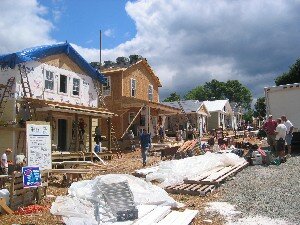Fifeville blitz! Six houses up in six days!
On Saturday morning, June 3, the start of the "Blitz," six foundations lined the new, still-dirt Nunley Street– created and named to honor the Nunley family, owners of Better Living Inc., who provided the lion's share of materials for the project. By Monday around noon, the houses had walls, windows, roofs, and front porches, and subcontractors were busy readying the interiors. What the...?
Over 150 volunteers swarmed over the houses like worker bees. The street, closed to traffic, presented a cacophony of hammering, sawing, and conversation. It was like an old-fashioned barn raising, only this time the workers were raising a small neighborhood.
Everyone knows architects can spend months– sometimes years– coming up with a workable design for a building project that then often takes months or years to build. But as part of Habitat for Humanity's 2006 Builder's Blitz, six local architects and builders were asked to do something a little different: design– and build!– six different houses in six days.
The Blitz is Habitat's single largest affordable housing effort in the organization's 30-year history. Between June 3 and June 10, the organization is building 500 homes across the country. Here in Charlottesville, the local chapter is building the six houses along a small street– created for the project in the Fifeville neighborhood.
With over 70 local businesses contributing time and materials, and donations covering about 90 percent of the $500,000 construction cost, it's definitely Charlottesville's single largest affordable housing effort. On Sunday, June 11, an official ceremony will mark the completion as the houses are handed over to their new owners. To qualify, the new owners cannot earn more than 50 percent of the area's median income, which is calculated at about $66,000, and in addition they must put 200 hours of "sweat equity" into a Habitat project. For this, they get a no-interest mortgage, and their payments go back into the Habitat building fund.
"I think it's really cool," says Overton McGehee, executive director of the chapter. "You drive through Fifeville, and every house is different, and on Nunley Street every house will be different."
What makes this particular Habitat undertaking unique, says UVA architecture professor Michael Bednar, who was in charge of coordinating the architects for the project, is that individual architects were chosen to design each house.
"Normally, Habitat uses their own standard designs," says Bednar, "but for this project they decided to team up architects with builders."
Initially, McGehee had asked Bednar to design all six houses, but Bednar suggested choosing a different architect for each to add interest. "I made six calls and got six yeses," says Bednar, who paired the designers with the builders by having the builders pick names out of a bowl.
"From what I hear," says Bednar, "the various teams have worked very well together, despite the challenges a project like this entails."
"I've never done anything like it before," says architect Leigh Herndon of Daggett & Grigg Architects, who designed the number-two house at the bottom of the hill. "It's very cool... I'd definitely do this again."
Herdon, like many of the other architects involved, says it was the close collaboration with builders and other architects that made the project so exciting.
"What I initially designed was not what ended up getting built," she says. "Originally, I had wanted a two-story porch, but after consulting with the builders, we realized it wasn't doable." Still, Herndon is happy with how the house is turning out. "I did get the standing seam metal roof I wanted," she laughs, adding, "and it was great working so closely with such friendly, with-it builders."
"We had to design so that it could be built fast," says architect Kelly Trout of BRW Architects, who designed the number-one house at the bottom of the hill along with principal Bruce Wardell. "We had a lot of conversation with the builders, a lot of collaboration on this project." For example, Trout points out that the roofers had a big influence on the design. "They told us they couldn't build as fast on the steeper roof we had designed, so we had to change that," she says.
The nature of the Habitat project itself also influenced what was built. "The pallet of donated materials definitely influenced our design," says Trout. "We had a limited number of materials to work with, and we had to decide how to use them appropriately." Trout also says they had to work within Habitat's design guidelines, as well as the neighborhood's, in trying to design something that was unique but still blended with the neighborhood.
"We definitely had to coordinate with the other six architects," says Trout. "Fortunately, the creative energy from all six architects was channeled in a similar direction. Each house is its own piece but also part of the neighborhood."
Both Trout and Herndon acknowledge that in a project like this, where time is of the essence, their designs were more like guidelines, with the builders themselves having to figure things out along the way.
"We have a lot of faith in the guys doing the building," says Trout.
Over 150 Habitat for Humanity volunteers are putting up six houses in six days in Fifeville.
PHOTO BY DAVE MCNAIR
#
